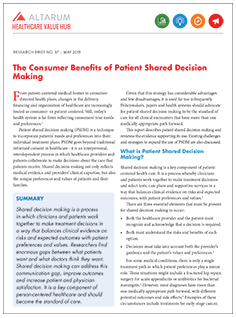Improving Value
Shared Decision Making
The U.S. healthcare system is notorious for being complex and difficult for patients to navigate on their own. Although there have been many efforts to increase patient activation, such as consumer-directed health plans and changes in delivery, today's health system is far from reflecting consumers' true needs and preferences.1
Patient shared decision-making (PSDM) incorporates patients' needs and preferences into their individual treatment plans. PSDM goes beyond traditional informed consent in healthcare - it is an interpersonal, interdependent process in which healthcare providers and patients collaborate to make decisions about the care that patients receive. Shared decision-making not only reflects medical evidence and providers' clinical expertise, but also the unique preferences and values of patients and their families.
The evidence around shared decision-making is fairly strong. Shared decision-making improved patient-doctor communications, improved outcomes and increased patient and physician satisfaction. Despite very promising evidence, shared decision making has not been widely implemented in clinical practice. In a study of more than 1,000 office visits in which more than 3,500 medical decisions were made, less than 10 percent of decisions met the minimum standards for shared decision making.2 Shared decision-making is a key component of person-centered healthcare and should be the standard of care. Training and physician reimbursement should reflect this priority.
Notes
1. Ditre, Joe, "Consumer-Centric Healthcare: Rhetoric vs. Reality," Healthcare Value Hub, Research Brief No. 18 (May 2017).
2. Braddock, Clarence H., et al., “Informed Decision Making in Outpatient Practice,” JAMA Network (December 1999).
- NASHP: Shared Decision-Making to Support Person and Family-Centered Care: Spotlight on Washington State's Patient Decision Aids (May 27, 2022).
- AHRQ: The CAHPS Ambulatory Care Improvement Guide: Practical Strategies for Improving Patient Experience
- Journal of General Internal Medicine: Core Elements of Shared Decision-Making for Women Considering Breast Cancer Screening: Results of a Modified Delphi Survey (March 19, 2020).
- Health Affairs: Potential Unintended Consequences of Recent Shared Decision Making Policy Initiatives (November 2019).
- Patient Advocate Foundation: The Roadmap to Consumer Clarity in Health Care Decision Making (May 2017).
- Cochrane Library: Decision Aids for People Facing Health Treatment of Screening Decisions (April 12, 2017).
- Health Affairs: Enhanced Support For Shared Decision Making Reduced Costs Of Care For Patients With Preference-Sensitive Conditions (February 2013).
- Health Affairs: Shared Decision Making: Examining Key Elements and Barriers to Adoption Into Routine Clinical Practice (February 2013).
- Center for Studying Health System Change: How Engaged are Consumers in Their Health and Health Care, and Why Does It Matter (October 2008).







